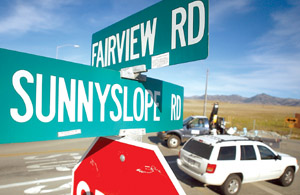The Dec. 6 car crash that killed two teens served as another
bitter reminder of two issues haunting the roadways of San Benito
County: Some rural roads aren’t so rural anymore, while drinking
and driving has further amplified often dangerous conditions.
Capt. Bob Davies, who heads the Gilroy-Hollister office of the
California Highway Patrol, reiterated his feelings on the subject
Monday.
The Dec. 6 car crash that killed two teens served as another bitter reminder of two issues haunting the roadways of San Benito County: Some rural roads aren’t so rural anymore, while drinking and driving has further amplified often dangerous conditions.
Capt. Bob Davies, who heads the Gilroy-Hollister office of the California Highway Patrol, reiterated his feelings on the subject Monday.
Projects to improve the safety of highways and other rural roads must move forward, while awareness of alcohol-related dangers on the road must jointly escalate, he said.
“(The county’s roadways) were built and designed for a population significantly less than we have now,” said Davies, who added that infrastructure upgrades haven’t adequately corresponded with population increases.
The county has continued roadway construction efforts – through its Public Works Department – to keep up with the boom of the 1990s.
Congestion of many rural roads has snowballed in recent years, particularly on Fairview Road, according to Arman Nazemi, assistant director of public works.
With Fairview serving as a bypass to several major highways, though, congestion problems have existed for as long as he can remember, he said.
Through traffic studies, the county found several locations on Fairview at the top of its most dangerous intersections list, Nazemi said.
Each spot toward the list’s top was the site of three to five accidents a year, he said.
“As traffic increases on Fairview Road, we will investigate other improvements needed to alleviate any potential problem,” he said.
In recent years, additional lanes – intended to enhance safety for drivers turning off the freeway – have been constructed at four separate intersections along Fairview Road, he said.
Public Works has also recently installed safety improvements at other locations tabbed as being dangerous – such as a stop sign at the intersection of Hillcrest Road and El Toro Drive, Nazemi said.
Plus, plans are in the works for more lane additions at two more intersections on Fairview, he said.
The intersection at Fairview and Santa Ana Valley roads, however, where the accident occurred Dec. 6, is not one of them. And it doesn’t necessitate changes, Nazemi insisted.
As the crash showed, Davies pointed out, another roadway problem in the county – drinking and driving – can bring about tragedy, even without congestion.
San Benito County, Davies said, has the highest per capita incidence of alcohol-related accidents within his office’s jurisdiction, which includes other South Valley cities such as Gilroy.
The 16-year-old driver, whom CHP investigators said admitted to drinking and driving, was traveling late at night on an open Santa Ana Valley Road toward the Fairview “T” intersection.
Two 18-year-old graduates of San Benito High School were killed in the crash. The speeding car bypassed a stop sign at the intersection, went airborne off an embankment 200 feet and rolled over in a nearby field.
“I’ve had a frustration point in trying to be alcohol free with juveniles,” Davies said. “And it hasn’t been all that accepted in that community.”
Davies and the CHP maintain jurisdiction over roadways throughout the county, aside from those within Hollister limits, he said. The agency’s primary concern when it comes to road construction plans, he said, is enhancement of drivers’ safety.
That’s why he and others stridently support the lane widening of both Highway 25 and Highway 156. More than 20 people have died in accidents on Highway 25 during the past three years.
And five people, Davies said, have died on the portion of Highway 156 proposed for expansion during that same span.
Environmental reviews of both Caltrans funded projects are expected to be done in about three years.
And both projects have expected completions of 2011, according to Lisa Berg, transportation planner for the Council of Governments.
An uncertainty, however, has brewed over highway projects statewide because of California’s budget constraints – as was expressed by local officials at the most recent COG meeting.
“Moneys earmarked for improvements to Highway 156 are clearly frozen at this point,” Davies said.
Whether the state-funded widening of Highway 25 stays on track, officials expect other safety improvements of the Highway 101 artery will move forward as planned, according to Berg.
Those blueprints include a constructed concrete median barrier and improvements to driveways and intersections along the highway.
The goal is to reduce potential for head-on collisions and provide more space for agricultural vehicles, officials say.
The $10 million project, funded mostly by the city’s Redevelopment Agency, should still start within two years and be completed by the end of 2006, Berg said Monday.
“It’s really additional safety improvements,” she said. “It has been called ‘interim’ in the past, but it’s really not. It’s additional safety improvements.”
Davies said ongoing improvements to Highway 25, along with public awareness, have already improved the level of safety on the roadway.
“The potential’s always there on Highway 25, but the risks on that road haven’t been that great,” Davies said.









